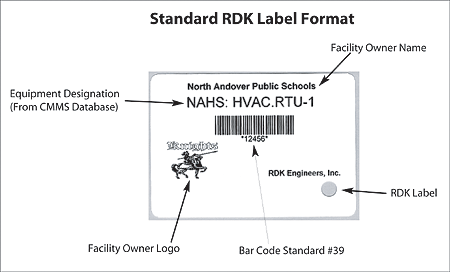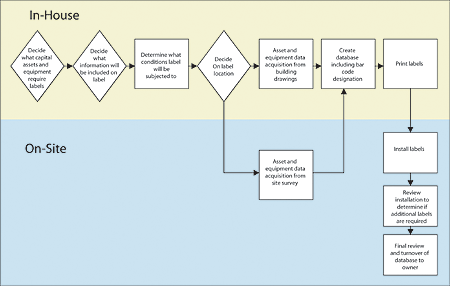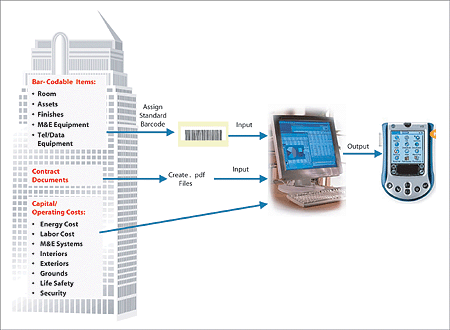
In this same boiler room, each piece of major equipment was also labeled with a metal plate inscribed with pertinent information like the equipment number (e.g., Boiler #1). Equipment and system automation consisted of full time boiler operators feeding coal to the fires, manually opening draft dampers, adjusting steam flow via hand valves, and logging operating parameters down on an hourly basis. It was communication technology at its finest for that period in time.
Leaping ahead to the 1960s and well into the 20th century, consulting engineers began to promulgate standardized contract specifications as word processing accelerated spec-writing tasks. At that point in time, it was common practice to cut and paste which really entailed cutting and stapling standard office specifications together on a job-by-job basis.
By the 1970s, this approach transitioned to computer-generated specifications. These specifications often found their way from one engineering office to another as engineers changed companies, taking with them copies of standard details, standard schedules, and standard specifications.
Like a contagious virus, computer software allowed 20th-century specifications based on 19th-century operating procedures to spread. Today, in the 21st century, we continue to embrace the requirement for valve tags and valve charts. One of the few changes that has occurred in identification labeling is that the engineering community has displaced equipment numbering on metal nameplates with plastic, laminated equipment labels. Not really an example of progress and innovative thinking!
While the design and construction community continues to hold fast to its antiquated means of inventorying equipment, valves, and components, time has passed us by. Simply go to the local food market, retail, or wholesale outlet, or office supply store and you will find barcoding to be the means to maintain inventory and to document sales. Receive a package from a delivery firm such as FedEx or UPS, and you will sign a handheld device that will record delivery and receipt of the package. Use the barcoded information and a package can be tracked from the time it leaves the manufacturer to its arrival at the local warehouse. A bar code is the key that opens the door to limitless application and information. As members of this diverse building industry, we need to keep pace with changing technology. This article is a wakeup call to those who design, construct, operate, and maintain buildings and the systems associated with these buildings.
Richard D. Kimball Company, Inc., (RDK) a Massachusetts-based engineering firm established in the 19th century - and probably the culprit for that first valve tag specification - is championing a concept to change those antiquated ways. The plan is simple: Today's management of buildings and assets should be built from a single database, and this database will become the cornerstone to efficient and effective management over the life of a facility. The key to access this efficient facility management process is bar codes and handheld computers.
It's All About The Database
With any good business plan comes an initial phase where data is collected to identify issues, concerns, and solutions. For RDK, the data collection process included interviewing building owners relative to bar code application. Beginning with facility managers and directors of operations, it was determined that the majority of building equipment and systems O&M were being maintained using antiquated, manual procedures. The use of computers and computer software was limited in this process.At the same time, while interviewing other professionals in these facilities, RDK noted that other groups were applying bar codes to their department equipment primarily for inventory control and material management.
For example, information technology (IT) groups were barcoding computer monitors while communication management groups were barcoding TV and overhead projectors. In unison with these barcoding efforts, others such as the financial group managing furnishings that included chairs, tables, etc., were also barcoding building assets too.
Through the data collection and analysis process it was determined that while some groups used bar codes and others did not, collectively these groups were not communicating among themselves as to methods, procedures, and application of the barcoding process.
Instead, it was found that frequently, groups worked independent of each other when it came to the application of barcoding and the associated database. Also noted was that many of those groups that did use barcoding did so without the ability to scan the tag. As a result, the bar code was simply being used for the number it noted below the bar code itself. Handheld computer with scanner capabilities would be step 2 for those who were using these labels possibly in the coming year or years.
At the same time, there were frequently departments within the same building that were not using this identification process at all.
The driving force to use bar codes appeared to be the quest to inventory assets for financial reasons. For one department, inventory simply meant tracking equipment being used by others, as is the case with communication groups who managed the use of overhead projectors, digital projectors, etc. In another department, fiscal management and the subsequent write-off of furnishings over a period of time was given as another reason to bar code equipment and materials.
Through roundtable discussions and one-on-one talks, RDK formulated a solution to the dilemma surrounding the application and/or lack of application of bar codes in the building industry. The common bond between all uses of equipment, material inventory, and other assets is the database. The means to quickly access this central database is the handheld computer with its bar code scanner.

Information Is Power If Used
Borrowing a quote from Tom Croteau, vice president, senior technology, Newspapers Association of America, "Technology no longer limits what we can do - but business sense does." Human nature dictates that change is often avoided at all cost until it becomes a necessity. This necessity is long overdue in the building industry. Businesses, institutions, and academia cannot afford to fall behind their competitors.The same can be said for the facilities that house and support these industries. Information is power if used and each department within a facility, a multibuilding complex, or at multiple sites requires efficient access to information. While each may have different requirements for maintaining asset database information, all these groups share a common need to get quick access to their specific database. They also have a need to standardize this database via policy and procedure. By standardizing the data into fields of information, the database can be sorted by numerous categories depending on the user.
Recognizing that a bar code is the key to accessing presorted information, standardizing on a specific bar code series (e.g., Code 39) will be critical to the success of database application. Also essential to successful database use will be the requirement to have specific fields of information programmed to various building user groups.
For example, a handheld computer scanning a bar code located in the upper right-hand corner of the doorframe may be programmed with a drop-down menu offering three-room programs. The first program may have been established to bring up, on the computer screen, the room assets (e.g., chairs, tables, and file cabinets). The second room program may bring up the IT assets (e.g., computers, monitors, and keyboards) while the third program may provide pertinent material information such as wall paint number, ceiling tile model number, and rug manufacturer and model number.
This same type of format could be programmed to scan the doorframe bar code when housekeeping enters to clean the room or the maintenance supervisor inventories dormitory room damages at the end of the school semester. Information can be powerful when easily accessed by "turning the key" (scanning the bar code).
By using a central database, the building management team can quickly, efficiently, and cost-effectively access information to meet their needs. In this example, whether the person entering the room is inventorying assets; IT equipment; repairing the walls, ceiling or floor; performing custodial work; or punch listing, the preprogrammed computer can bring up those fields of information essential for the person needing this information. Centralizing all information into one database simplifies the job for a computer programmer to then create individual or mini-database for each department's needs.
Specifying The Label
In its infancy, bar code technology and its use were limited in part due to the lack of inexpensive, portable bar code scanners. Today, with the familiarity and everyday use of palm pilots, users are better prepared to embrace bar code technology and all the benefits it brings to the enduser.
So how does the building industry embrace this technology? First, the label must be durable, meaning it must be specified to withstand the elements (water, ultraviolet rays, heat, etc.). Attention needs to be given to the possibility of the adhesive losing its bonding strength over time before selecting stick-on labels. When placing a label on a motor, pipe, or device with a surface temperature of 140°F to temperatures in excess of 240°, caution needs to be taken relative to the label's durability. Too much heat and the label can turn black. To much sunlight and the label can turn white. These labels may also require withstanding exposure to oil, chemicals, etc. Durability also means the capacity to withstand high winds or simply a vandal attempting to tear the label off of the equipment or device. RDK's preferred method has been to use cabling ties to secure labels to equipment.
Specifying The Software
There are several bar code software programs available on the market, as a quick search of the Internet will show. One important requirement of a bar code program is its ability to print labels and tags using standard printers, avoiding a special or separate printer. RDK's preference for labels has been prepurchased, blank 4-in.-by-2-1/2-in. labels, eight to a sheet with prepunched holes for the cable ties.RDK uses Print Studio 1.0 Professional software by Jolly, Inc. Labels can be customized to include the equipment number, the bar code number, the client's logo and RDK logo.
This particular software program has allowed RDK to input the data to the readily available Microsoft® Excel database as the means to hold the information. Larger databases require more powerful software (e.g., Microsoft's Access or Sequel Server).
The computerized spreadsheet process also serves as the platform by which pertinent information can also be downloaded into a CMMS system, another business tool for asset management. This same Excel file is also adaptable to handheld computer application that can be accessed when the computer scans the applicable bar code.
While customizing labels may require some creativity, staying with commercial software (e.g., Microsoft 2000) and handheld computers (e.g., Hewlett-Packard, Dell, etc.) will allow the applications to be user friendly and transferable to other software programs and project files.
Implementing The Installation
Once the decision to bar code equipment is made, policy and procedures must be created and a plan must be formulated. Without a definitive plan, the process becomes exceedingly difficult. The plan requires decisions on what types of equipment will be labeled, what type of database will be used, the design of the label, data required on the label, which barcode standard will be used, and how to print and install the labels.At RDK, an installation checklist was developed to standardize and maintain a quality control process. With various RDK staff assigned to a diversity of projects including a new $375 million sports complex, a new 300,000-sq-ft public high school, and multiple buildings on a college campus, standardized protocol proved to be invaluable as consistency was maintained through barcoding procedures.
Once the types of equipment to be labeled have been determined (i.e. HVAC, electrical, plumbing, office equipment, etc.), the database must be created. The most important data field in a database will be the identifier number for each entry into the system. Without the separate identifier, the database will not be able to organize the data correctly and, during the sorting process, information will become mixed and not match the appropriate equipment.
Examples of recommended fields of data may include equipment designation, building, level, room, etc. Depending on the number of department users who will draw from the central database, several other fields of information will need to be included. Other pertinent fields of info will be area served, the make and model, serial number, etc.
The process and execution of on-site bar code labeling must also be well orchestrated to perform the task at-hand efficiently and cost-effectively. A well-managed process monitored and measured with quality control will contribute to a final product, delivered on time and in budget. The cornerstone to this success was captured within RDK's "Tagging Standards" manual that addressed where to place/secure labels and where not to secure labels. Concerns relative to access and ease of scanning the label, obstructions, methods of attachment, and tools and materials required are all included in the manual.

Lessons Learned
One lesson learned from installing bar code labels for equipment located at ladder level or higher has been to tag the motor disconnect, which is routinely located at floor level. When the bar code is scanned, the program brings up the lock-out/tag-out safety requirements. Before someone has to climb a ladder or portable lift, the label/computer program process reminds the technician of essential safety measures before serving the piece of equipment. This approach also reinforces added value to the management staff that they have provided the appropriate tools to their technician to perform their work in a safe environment.Not everything will need a bar code label. Another lesson learned has been to consolidate equipment such as electrical panels and bar code the electrical room door rather then six or eight electrical panels within an electrical closet. The handheld computer can scan the bar code and bring up the multiple pieces of equipment inventoried under this single label. The same can be said for consolidating several fancoil units (e.g., an entire floor of hotel guest room units where scanning one label will bring up the several fancoil unit PM workorders listed by room numbers). ES
